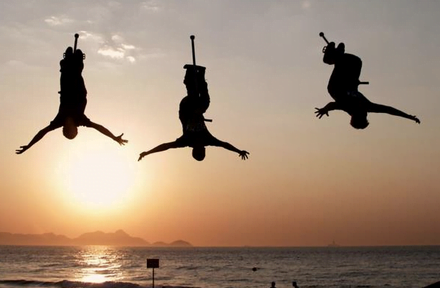Pogo sticks are a popular toy that has been around for decades. They are one of the best toys ever made, with many parents choosing them as their child’s first ride-on toy.
In this blog post, we will explore When were pogo sticks popular? Who created them and what did they look like? why pogo sticks have retained their popularity over the years and what trends in the past may affect where they go in the future.
Pogo Stick History
Pogo sticks are one of the oldest forms of playground equipment. They were first patented by George Hansburg, Sr., a Canadian, on March 18th, 1931. The patent states that this product is designed “to enable children to enjoy themselves more.”
She also makes an argument for their use as a form of physical therapy. Reynolds, in her article “Pogo Sticks as Physical Therapy,” argues that the Pogo provides a way to improve balance and coordination.
The first mention of pogo sticks was by George Hansburg Sr., who patented them on March 18th, 1931. He claimed they were designed for children so they could enjoy themselves more. Since then, pogo sticks have been a popular form of recreational activity around the world for people of all ages.
The popularity of Pogo Sticks in the Past
By the early 1970s, Pogo Stick was one of the hottest toys for children and adults alike. They also became a popular form of exercise at this time as well with people using them to jump over large distances or perform tricks on ramps and other obstacles that would have been hard to do with a skateboard.
In the 1980s, Pogo Stick was still popular but it had been replaced by other similar products and activities like inline skating.
The 1990s saw an increase in the popularity of sports such as snowboarding, also known as “skiing on water,” which brought many new forms of recreation to people’s attention. This is just a small sampling of the popularity and trends in pogo sticks over time.
Trends with Pogo Sticks in the Past
- In the 1960s, Pogo Stick’s popularity was at its peak.
- The invention of modern pogo sticks as we know them today happened in 1965. Before then they were a very different invention that had been used for centuries and was more like poles with springs on top to help people jump higher off horses back or from tree branches.
- Pogo sticks became popular for recreational purposes in the 1980s with a boom of commercial products appearing.
- They were also used in various war efforts during World War II as part of training drills; they helped soldiers learn how to jump over obstacles without getting hurt
- After World War II, pogo sticks fell out of favor until 1980 when they reappeared, and their popularity has grown ever since
- In the early 20th century, pogo sticks became popular with circus performers and were marketed to children as a new type of toy
- In 2006, Razor released their first pogo stick and was responsible for renewing interest in the product again which continues today.
- There are many more companies producing pogo sticks today that offer a variety of features and styles. They range in price from about $20 to over $200 depending on the type, size, and function you want. The most popular models this year seem to be those with Bluetooth speakers or built-in lights for nighttime use.
- Today, they are used by children and adults for both recreational purposes and to increase physical activity.
Future of Pogo Sticks

- In the future, pogo sticks reviews are likely to continue being popular as they have been in recent years.
- With Razor’s recent release of the Pogo Jumper, it is possible that they will be able to capture even more market share and pogo sticks may take over as one of the top toys for kids.
- For most people living in urban areas, a traditional pogo stick might seem like an old-fashioned toy not used by many.
- Pogo sticks are still extremely popular with children and adults alike. Pogo sticks have been around for centuries but did not become commercially available until the 1960s when they were marketed to kids as a new toy.
Conclusion
Pogo sticks are a blast from the past, but they are still popular today. For example, in 2018 there was an increase of pogo-stick-related injuries than any other year since 2010 and it is not slowing down. In 2021 we will see more people looking to get their bounce back! So, what will be next for this retro toy? We cannot wait to find out!













![How To Open an Inground Pool [Complete Guide]](https://www.organizewithsandy.com/wp-content/uploads/2021/06/How-To-Open-an-Inground-Pool-Complete-Guide-180x180.jpg)
Comments